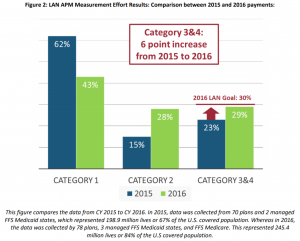| CLICK HERE and let us discuss how BHM plays an important role in payment review processes. |
 Health plans of all sizes are interested to learn where they stand in the movement toward alternative payment models (APMs) – that is, shared savings, shared risk, bundled payments, or population-based payments and how they compare to the market. Some health plans adopt APMs because of market conditions, others by factors such as data system limitations or provider readiness.
Health plans of all sizes are interested to learn where they stand in the movement toward alternative payment models (APMs) – that is, shared savings, shared risk, bundled payments, or population-based payments and how they compare to the market. Some health plans adopt APMs because of market conditions, others by factors such as data system limitations or provider readiness.
A released report, by the Health Care Payment Learning & Action Network (LAN), showed that 29% of total U.S. health care payments were tied to alternative payment models (APMs) in 2016 compared to 23% in 2015, an increase of six percentage points.
Payment reform plays a critical role in building a health care system that results in better accessibility, quality, affordability, empowerment, and innovation.
Results were in line with the goals of the LAN to tie 30% of total U.S. health care payments to APMs by 2016 and 50% by 2018. Detailed findings can be accessed via the LAN Website.
Health Plans Adopt APMs
The survey collected data from over 80 participants, accounting for nearly 245.4 million people, or 84%, of the covered U.S. population. The LAN APM Measurement Effort determined the following results:
- 43% of health care dollars in Category 1 (e.g., traditional FFS or other legacy payments not linked to quality)
- 28% of health care dollars in Category 2 (e.g., pay-for-performance or care coordination fees)
- 29% of health care dollars in a composite of Categories 3 and 4 (e.g., shared savings, shared risk, bundled payments, or population-based payments)
With over 800 attendees, results were announced at the LAN Summit on October 30 in Arlington, VA by Mark McClellan, Co-Chair, LAN Guiding Committee.
“As health care expenditures and capabilities have continued to rise, it’s vital that we find ways to significantly reduce the cost burden for both consumers and the health care system,” said McClellan, Co-Chair, LAN Guiding Committee; Director, Robert J. Margolis Center for Health Policy. “This measurement effort represents the kind of collaboration between the public and private sectors to make real progress on improving care.”
Detailed Findings
Report findings show some interesting trends. First, there was a shift away from legacy FFS payments and a marked growth in Category 2, where payments are tied to value. Second, there was a six percentage point increase in alternative payment model payments (Category 3 and 4), bringing total APM spending to approximately $354.5 billion dollars nationally. A table comparing 2015 and 2016 payment years can be found below and an analysis of the results can be accessed here.
| Payment Year | Cat 1 | Cat 2 | Cat 3&4 | Data Sources | Lives (#) | Covered Lives (%) | |
| 2016 | 43% | 28% | 29% | 78 plans, 3 managed FFS Medicaid states, FFS Medicare | 245.4 mill | 84% | |
| 2015 | 62% | 15% | 23% | 70 plans, 2 managed FFS Medicaid states | 198.9 mill | 67% |
Health plans have shifted away from the traditional FFS approach to value-based reimbursements because they recognize that APMs show promising results in terms of improved quality and cost outcomes.
“We are encouraged by these results and the great progress being made towards APM adoption,” said Trent Haywood, Chief Medical Officer at the Blue Cross and Blue Shield Association.
“These findings underscore the importance of the public and private sectors working in concert supporting providers towards APM adoption. We know that providers need information and support from health plans to take on risk. This Measurement Effort helps develop the rationale for continued payment reform, and we as health plans must continue to share information, clinical support and data on spending and quality to determine to encourage further progress.”
The LAN, launched in March 2015 by the U.S. Department of Health and Human Services, convenes the public, private, and non-profit sectors to drive adoption and alignment of APMs. These payment models drive reform in the health care system’s payment structure that incentivize improved health outcomes and quality of care over the quantity of services provided.
The report marks the second year of the LAN APM Measurement Effort, the largest and most comprehensive of its kind at the national level. The findings capture actual 2016 health care spending from four data sources: the LAN, America’s Health Insurance Plans (AHIP), the Blue Cross Blue Shield Association (BCBSA), and the Centers for Medicare and Medicaid Services (CMS) across commercial, Medicaid, Medicare Advantage, and fee-for-service (FFS) Medicare market segments, and categorize them according to the four categories of the original LAN APM Framework.
Through the LAN’s collaborative structure, more than 7,100 participants are taking action towards APM adoption and implementation.
The LAN has adopted the goal of tying 50% of U.S. health care payments to APMs by the end of 2018. For more information, go to www.hcp-lan.org.
CLICK HERE and let us discuss how BHM plays an important role in payment review processes.
